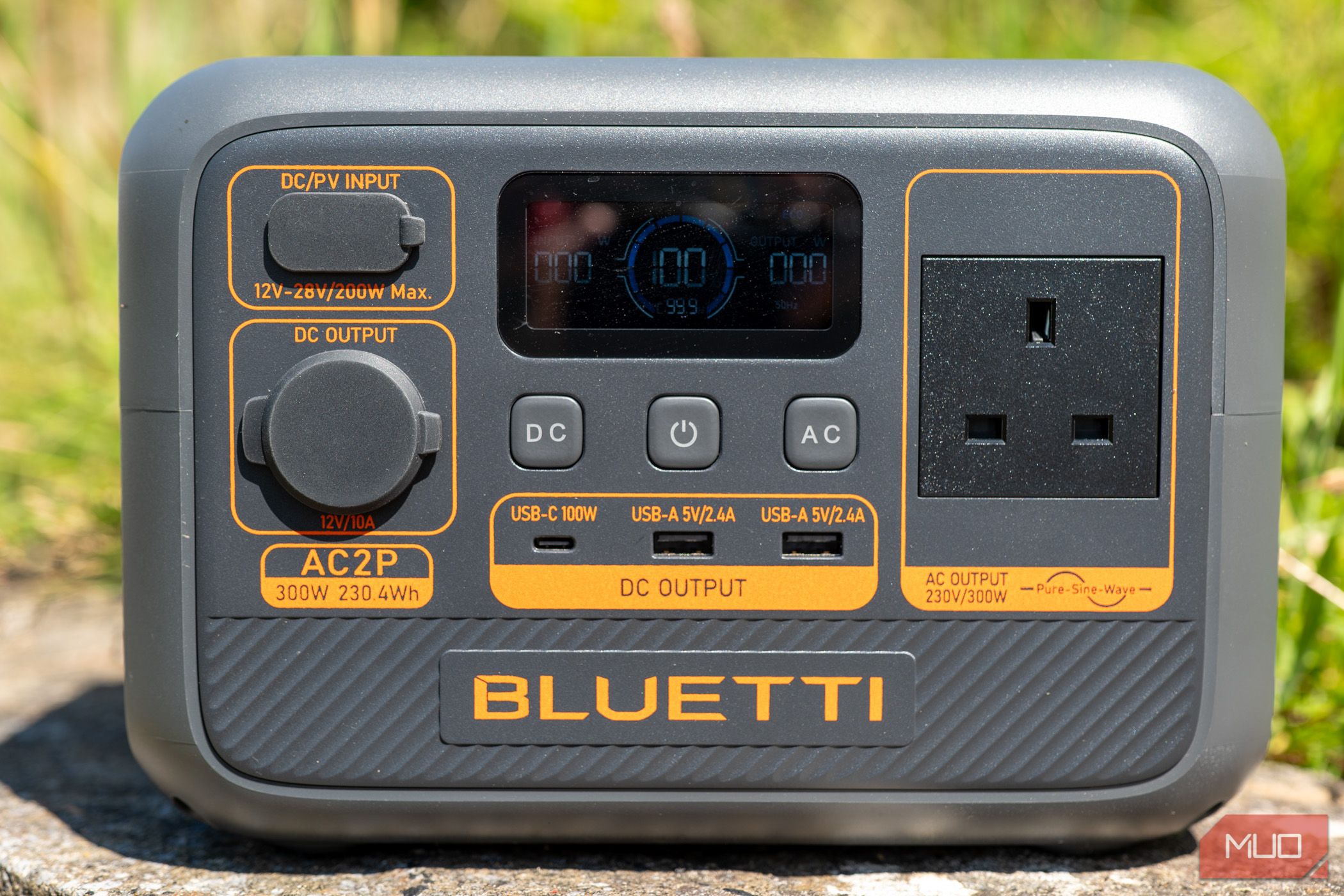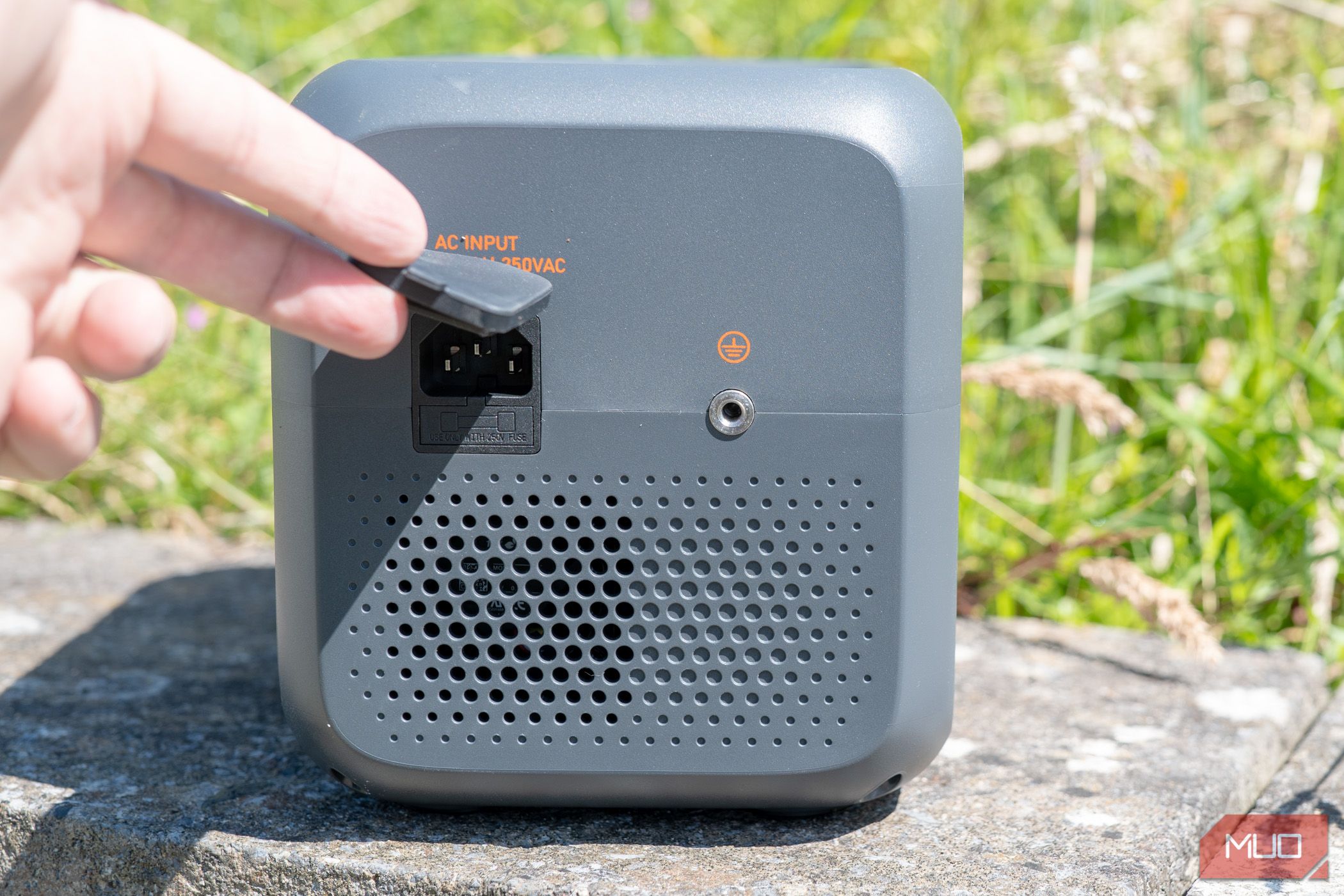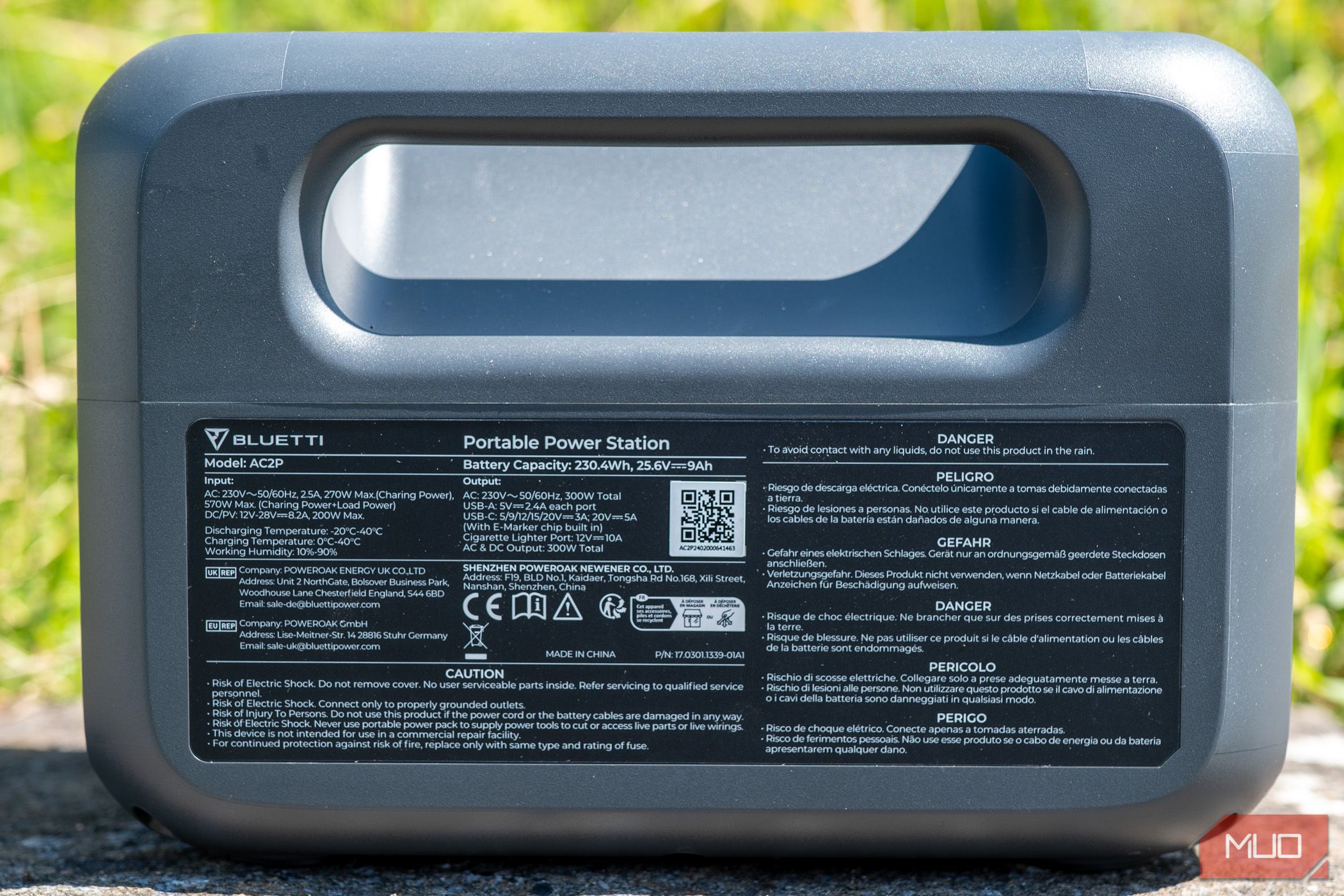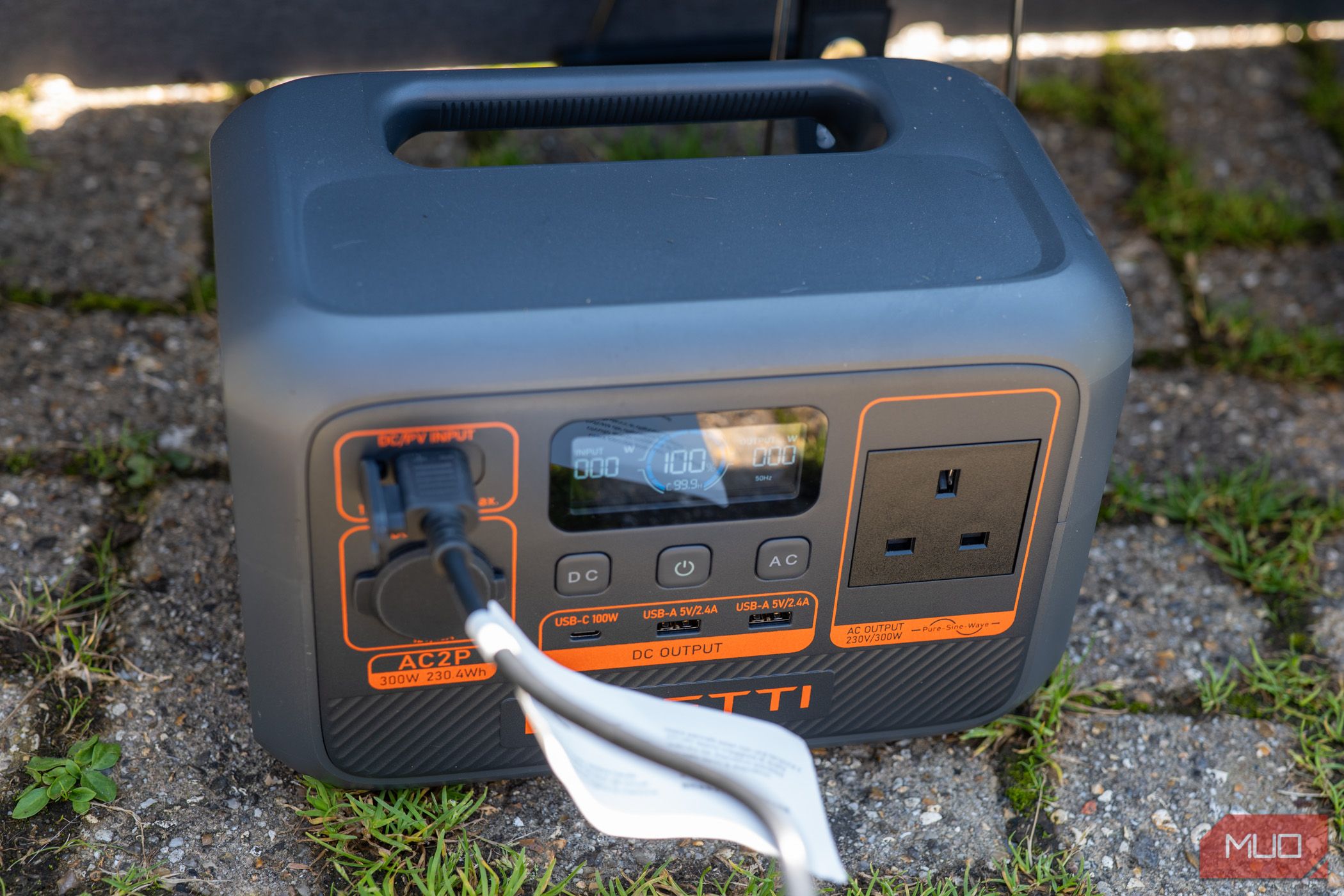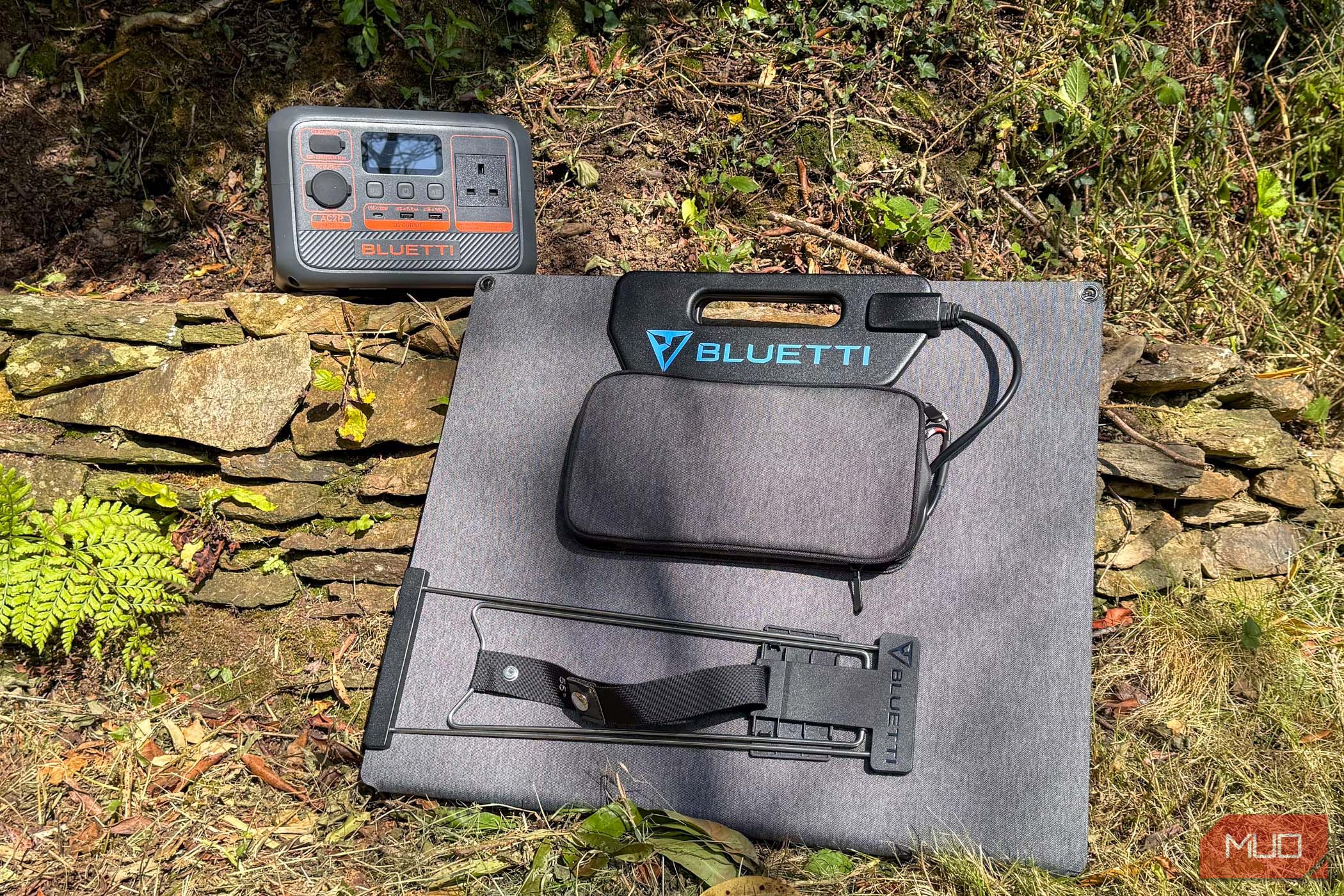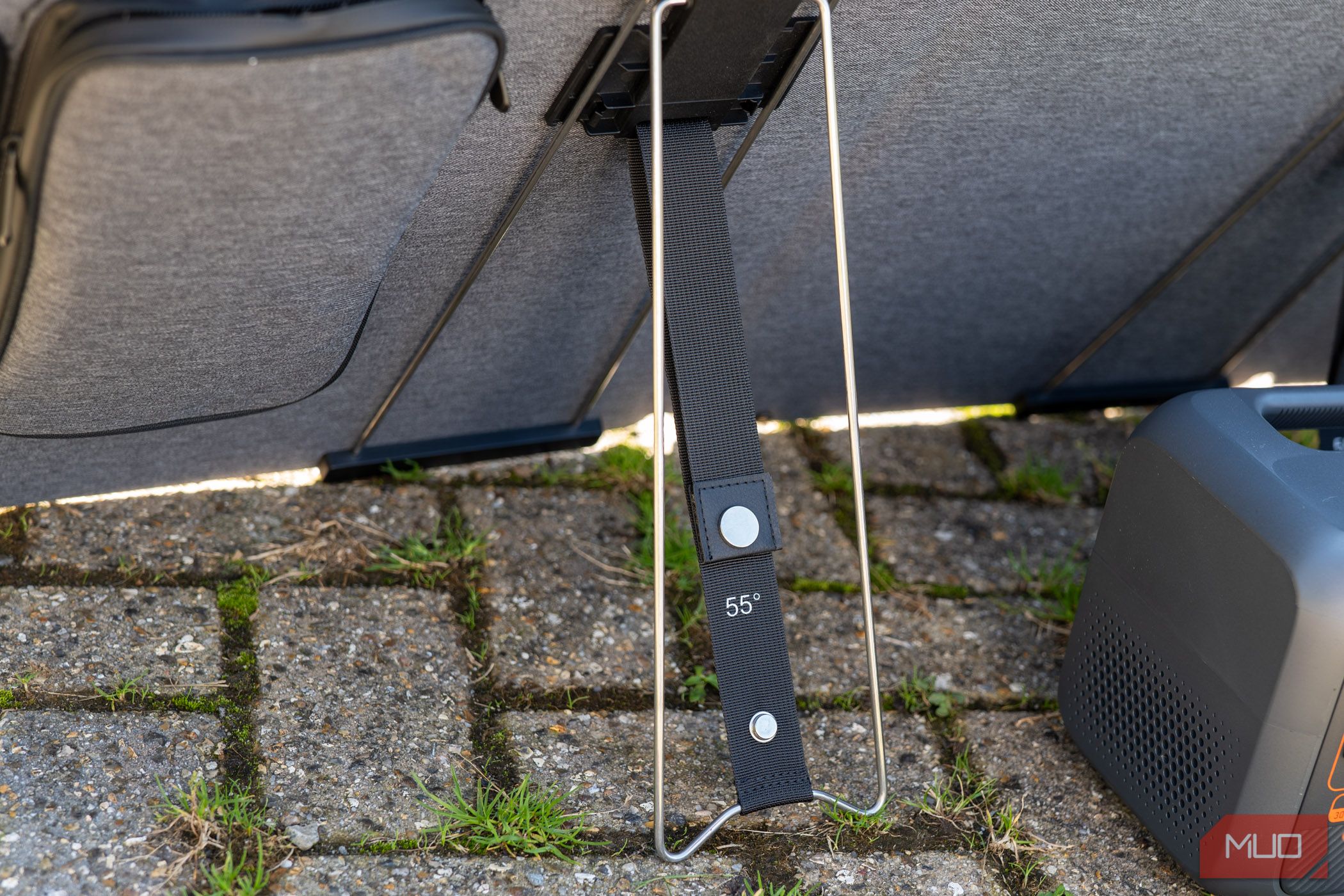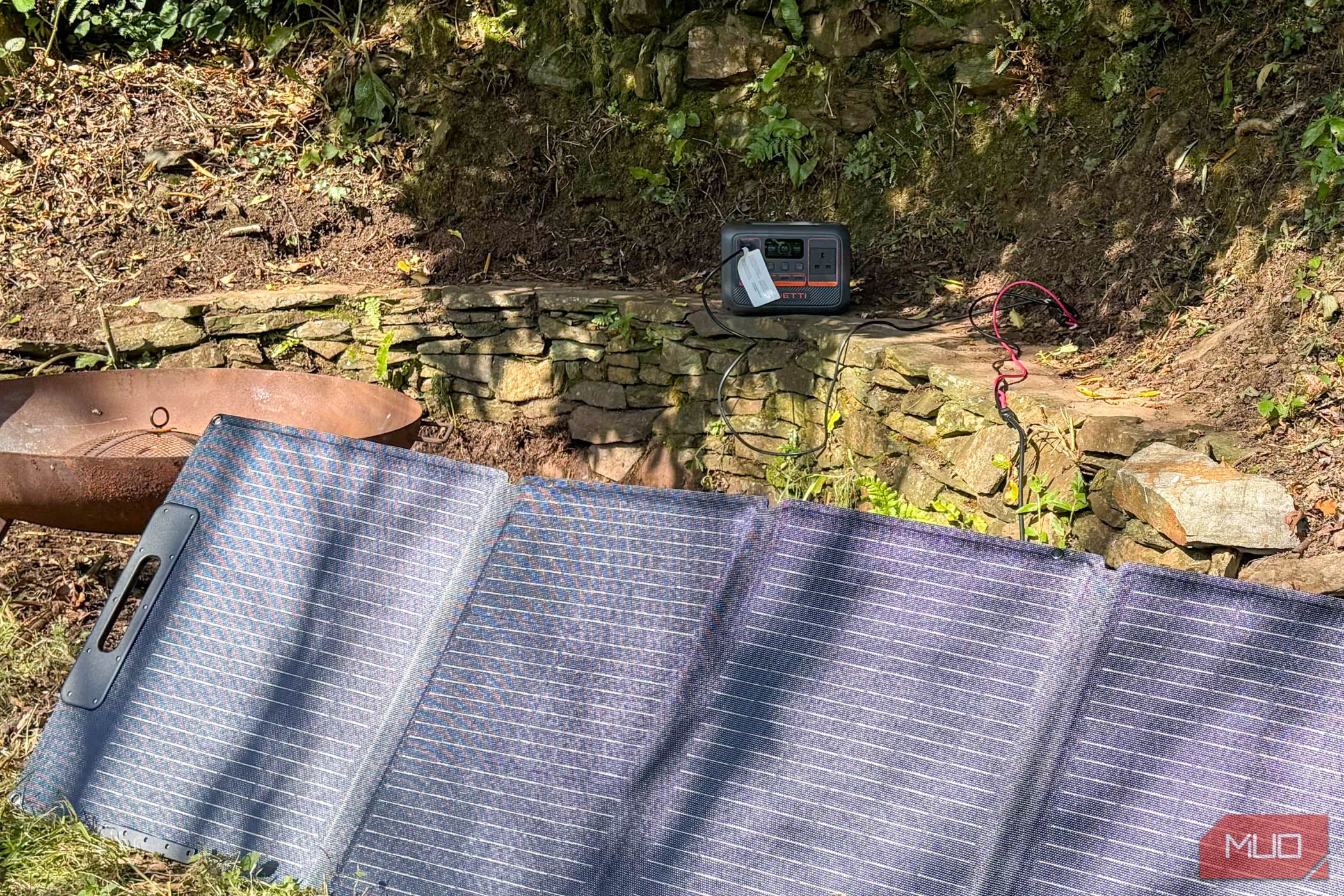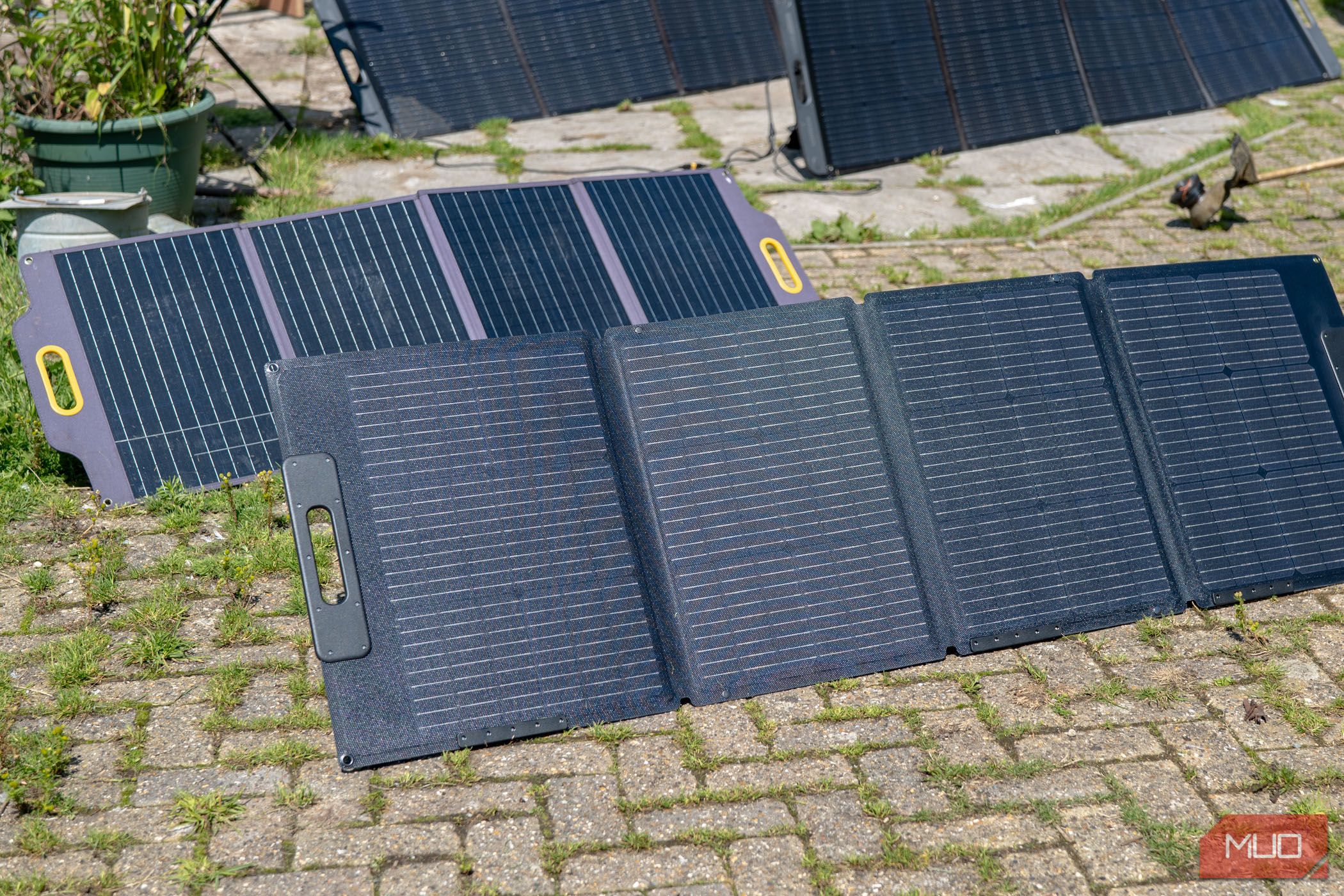Key Takeaways
- The Bluetti AC2P is small but can power 300W AC devices and fast charge in less than 2 hours.
- The sleek design includes standard input ports and an LCD screen, but the number of output ports is slightly disappointing.
- The PV120S solar panel charges AC2P in 3 hours; it’s perfect for short trips.
With a 230Wh capacity, the Bluetti AC2P is the smallest backup battery in the Bluetti range, yet still maintains the ability to power 300W AC devices, fast charges in less than two hours, and can be hooked up to 200W of solar. It’s the perfect size to fit in your backpack for camping or hiking and pairs well with the Bluetti PV120S portable solar panel. But make sure you only use the AC socket sparingly because it’ll drain the power quickly.
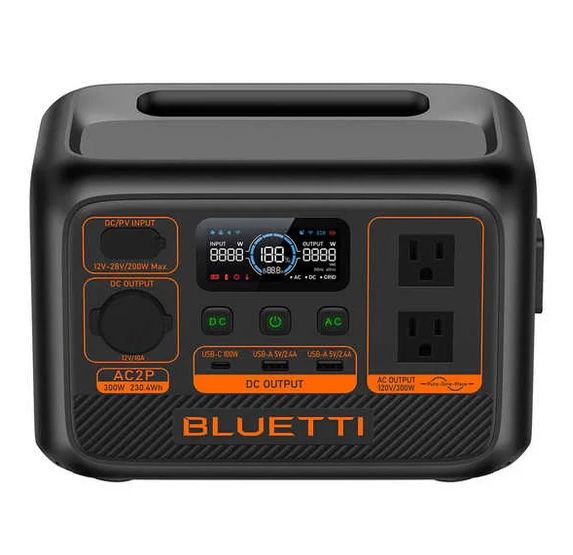

Bluetti AC2P
The AC2P is small enough to be packed in your rucksack and taken camping or hiking to provide enough power for the weekend—potentially indefinitely when paired with the superb PV120S solar panel. Although the AC ports are capable of up to 300W sustained, you should use them sparingly as even low-power AC devices will drain the battery quickly.
- Small and easy to carry or pack away in your bag
- Pairs well with the PV120S solar panel to recharge in less than three hours
- Capable of 300W AC output for emergencies
- Any use of the AC ports will drain the battery faster than expected
- The number of USB ports is disappointing
- Lacks additional features like an emergency light
Specifications and Availability
The Bluetti AC2P is available now at for $250 from official outlets, but can be found as low as $190 if you shop around. It can also be purchased in a bundle with a suitable 120W solar panel for $500.
Design: Sleek and Perfectly Portable
At 3.6kg (7.9 lbs), the AC2P is a refreshingly small 250 × 156.5 × 174.5mm (9.8 x 6.16 x 6.87 inches) power bank with an integral fixed handle in the top rear of the case.
In a break with tradition for Bluetti, the input ports have been aligned with most batteries on the market: the solar input now uses a universal XT60 connector, and the AC charging port on the side is an IEC “kettle lead” (the same as your PC).
In the past, Bluetti has opted for a more obscure 9mm DC plug for solar, and a proprietary screw-in cable for AC, so this is a welcome change. I suspect this is a one-off change, though, with an exception made for the small-capacity portable unit, given that Bluetti already has an extension ecosystem of solar generators and expansion batteries.
The AC input on the side, the car socket, and the DC/PV input port feature rubber bumpers, though the USB ports are exposed. As with most battery packs (the Bluetti AC60 being the exception), the AC2P isn’t waterproof, nor should it be left in the rain. Everything is neatly labeled in bright orange, with a basic but easy-to-read LCD screen and soft-touch power buttons; hold down for a second or two to activate the power and enable outputs.
As a battery designed primarily for camping and hiking, it would have been nice to see a large light panel on the side, allowing it to do double duty as a handheld flashlight. I can’t get over how useful I found the built-in flashlights on the Anker Solix C800 Plus to be (even if it is significantly larger than the AC2P).
To access some advanced settings of the AC2P, you’ll need to use the Bluetti smartphone app (available on iPhone and Android). The app gives a basic overview of current power flows and allows you to change the charge rate or tweak the ECO power-saving mode, which automatically deactivates outputs when the power drawer is below a certain threshold. It’s not widely publicized, and no button pressing is required to enable Bluetooth, nor do you even need to make an account; open up the app, and it’ll automatically detect the battery.
Output Ports: Meager, but Probably Enough
With one or two AC sockets (UK and US models, respectively) capable of up to 300W sustained output and 600W surge, you’re not going to be powering large appliances on this, but it’s still impressive. If you have an older laptop that can’t be powered through USB-C PD, it’ll do the job there. Beware that any use of the AC port will quickly drain such a small-capacity battery; running the AC converter uses power. This is negligible on a larger battery, but on something this small, it should only be considered for emergencies. Trying to run something at the full 300W output would deplete the battery in half an hour or less.
I wouldn’t rely on this for medical use overnight, for instance. A CPAP machine typically draws 30-35W. In an ideal world, the 230Wh capacity would last for just under eight hours. In reality, you lose some power to conversion efficiency; it may not last a full night’s sleep.
To test this, I plugged in my aging laptop, which has a severely degraded battery, and left it streaming some YouTube videos. The reported power draw settled around 15W, with occasional spikes of up to 25W. The AC2P estimated 9.8 hours of run time initially. You might note that 230Wh divided by 15W should be closer to 15 hours; again, this is due to the conversion inefficiency.
I started the test at 10 am, and at 4:30 pm, it had all but depleted to 5% remaining. So, the actual run time was more like 6.5 hours. The power draw likely peaked higher at times, but this still shows that for AC appliances, you shouldn’t rely too heavily on the estimated time, nor should you run anything medically critical on this. Use the AC socket sparingly if you want to keep your USB devices charged. Always opt for a direct DC connection when possible; this is how the energy is stored.
In addition to the usual 12V car socket for portable appliances, there are a handful of USB ports: a single USB-C PD (100W) and two USB-A (12W maximum). This is a little disappointing, given that I’d say the primary purpose of this size battery is to charge your smartphone and other portable devices. If you need something to service a larger family’s worth of devices, you should look at a larger capacity.
Fast Charging on Solar
I was sent a 120W small solar panel to test with this, and it’s an ideal size for portability. You might not take it hiking for the day, but you could carry it from the car to a campsite without issue.
The Bluetti AC2P has a maximum solar input of 200W, with an operating voltage of 12-28V. 200W is the largest portable panel you’ll commonly find; beyond that, you’re looking at static panels only. For this capacity, it’s more than sufficient. Assuming a realistic input of 100W with good sun, it’ll take three hours to charge up. In testing, the 120W panel I received produced a maximum input of 99W.
You can also recharge the AC2P from a car or a wall socket, both of which take as little as one and a half hours in turbo mode, though this must be enabled via the app. AC charging is set to a more leisurely pace by default, which will take four hours and is better for the overall battery health.
Solar Panel PV120S: Outstanding Performance and Design
Though not the main focus of my review, the PV120S’s performance is impressive, and it has some handy design features. The monocrystalline ETFE-coated panels unfold easily into four rigid sections, featuring a carrying handle with a light grey woven fabric backing.
The first feature I really appreciated was the kickstands; each is a simple metal stand that clicks out easily. These are supported by a fabric strap, with press studs to change the length of the fabric, labeled in 10-degree increments. This lets you angle it optimally to catch the most sun: 35, 45, or 55 degrees. Most portable panels are stuck at 45 degrees only.
The only other thing I’d love to see on the PV120S is an angle guide—a small dot on a piece of transparent plastic that projects onto a circle to show when the panels directly face the sun.
As for connectivity, a pocket on the rear provides storage for the hardwired cable with MC4 connectors. You’ll also need to use the MC4 to XT60 cable included with the AC2P to charge it. This is a little unusual for a portable panel—most come directly with XT60 or 9mm DC cables. Some panels even include a USB port or cable to charge your electronics directly without needing a battery. There’s enough room to leave the MC4 to XT60 converter cable connected and tucked inside the pocket.
I appreciate the standard connectors, which means you can use this panel with any battery. Still, it’s an unusual amount of cable bulk for what is otherwise a very portable product. On the plus side, it gives you a longer cable run than average to position your AC2P out of the sun.
In terms of actual performance, you should never take the stated Wattage output as guaranteed. I have 200W-rated panels that produce less than this 120W-rated panel.
To test the performance of the Bluetti PV120S, I put it up against a similarly specced 120W panel from a competitor. While they differ in features (the other panel features a selection of built-in cables, including USB-C), the performance also showed a marked difference. In the same conditions, the AC2P reported 99W from the PV120S, while the competitor reported 82W. Some of this is from degradation due to age, but even in peak performance, I’ve never had more than 90W total from the other panel—and that was easily the most impressive I’d tested in a long time.
Despite being only 120W, the Bluetti PV120S perfectly matches the AC20P. With a typical 100W output, it’ll take around two and a half to three hours to charge this small battery fully. Technically, the AC2P battery can handle up to 200W input, but I think that’s overkill—the PV120S is more than enough to get you juiced back up again.
Unfortunately, it looks like the PV120S is only available in Europe. The PV120D is the equivalent model listed in the US at the moment but features a different design. The PV120S costs about the same as the AC2P itself, doubling your overall purchase price.
Should You Buy the Bluetti AC2P?
The Bluetti AC2P is about the same electrical capacity as a 50,000mAh backup battery bank but can be charged a lot faster, has solar input, and features superior Lithium Iron Phosphate battery cells for up to 3000 cycles before it degrades to 80% capacity. Smartphone power banks are usually Lithium Ion, which degrades more quickly in as little as 800 cycles. It’s more expensive than the equivalent basic power bank and has the added bulk of an AC converter and solar MPPT charging circuit. So, if you don’t plan on using the AC socket, charging over solar, or getting regular use of it to notice the longevity of the cells, it’s not worth it.
Compared to other “solar generators,” the AC2P is similarly priced for its capacity at around $1 per Wh, but with less output possible. The PV120S solar panel is also fairly priced compared to other portable panels, and any small premium is justified by its stellar performance. But it’s still twice what the equivalent static panel would cost, as the portability comes with its own premium. If you’re using a cabin as a base camp and only need the AC2P for one or two-day hikes, your budget would be better spent on static panels for the cabin.
It’s best not to think of the Bluetti AC2P as a “solar generator” in the same sense you would other large-capacity batteries. But yes, technically, it can handle small AC appliances for short periods of time, and it can be recharged quickly with a small solar panel. Instead, consider it as a massive portable power bank for your phone and other small electronics when traveling light—with AC output if you’re desperate—and you won’t be disappointed. It’s small and light enough to throw in your backpack for a short hike, and will easily last you for a whole weekend break—potentially indefinitely when paired with a solar panel. However, I can’t shake the feeling that Bluetti has missed a trick here by not including any lighting.


Bluetti AC2P
The AC2P is small enough to be packed in your rucksack and taken camping or hiking to provide enough power for the weekend—potentially indefinitely when paired with the superb PV120S solar panel. Although the AC ports are capable of up to 300W sustained, you should use them sparingly as even low-power AC devices will drain the battery quickly.

